



































































You want new charts?
You got new charts! Explore the ocean with vibrant terrain & depth shading, using all-new TZ MAPS. Don’t just take our word for it. See for yourself. Scan here, and we’ll show you!






































































You want new charts?
You got new charts! Explore the ocean with vibrant terrain & depth shading, using all-new TZ MAPS. Don’t just take our word for it. See for yourself. Scan here, and we’ll show you!

The very best hunting knives possess a perfect balance of form and function. They’re carefully constructed from fine materials, but also have that little something extra to connect the owner with nature. If you’re on the hunt for a knife that combines impeccable craftsmanship with a sense of wonder, the $79 Huntsman Blade is the trophy you’re looking for.
The blade is full tang, meaning it doesn’t stop at the handle but extends to the length of the grip for the ultimate in strength. The blade is made from 420 surgical steel, famed for its sharpness and its resistance to corrosion.
The handle is made from genuine natural bone, and features decorative wood spacers and a hand-carved motif of two overlapping feathers— a reminder for you to respect and connect with the natural world.
This fusion of substance and style can garner a high price tag out in the marketplace. In fact, we found full tang, stainless steel blades with bone handles in excess of $2,000. Well, that won’t cut it around here. We have mastered the hunt for the best deal, and in turn pass the spoils on to our customers.
But we don’t stop there. While supplies last, we’ll include a pair of $99 8x21 power compact binoculars and a genuine leather sheath FREE when you purchase the Huntsman Blade Your satisfaction is 100% guaranteed. Feel the knife in your hands, wear it on your hip, inspect the impeccable craftsmanship. If you don’t feel like we cut you a fair deal, send it back within 30 days for a complete refund of the item price. Limited Reserves. A deal like this won’t last long. We have only 1120 Huntsman Blades for this ad only. Don’t let this beauty slip through your fingers. Call today!

Huntsman Blade $249* Offer Code Price Only $79 + S&P Save $170
1-800-333-2045
Your Insider Offer Code: HBK249-01
You must use the insider offer code to get our special price.
Stauer® 8x21
Compact Binoculars -a $99 valuewith purchase of Huntsman Blade

What Stauer Clients Are Saying About Our Knives
“This knife is beautiful!”
— J., La Crescent, MN
“The feel of this knife is unbelievable...this is an incredibly fine instrument.”
— H., Arvada, CO

Rating of A+
14091 Southcross Drive W., Dept. HBK249-01 Burnsville, Minnesota 55337 www.stauer.com
*Discount is only for customers who use the offer code versus the listed original Stauer.com price.
California residents please call 1-800-333-2045 regarding Proposition 65 regulations before purchasing this product.
• 12” overall length; 6 ¹⁄2” stainless steel full tang blade • Genuine bone handle with brass hand guard & bolsters • Includes genuine leather sheath




























Embarking on the open water is an exhilarating experience, flled with the promise of adventure and relaxation. Whether you’re a seasoned sailor or a weekend cruiser, protecting your vessel with proper insurance is not just a choice—it’s a necessity. Explore the reasons why every boat owner should prioritize boat insurance for a worry-free voyage.
The open water can be unpredictable, with unexpected storms, collisions, or other potential accidents. Boat insurance can give you fnancial protection if there is damage to your vessel, providing coverage for repairs or replacement.
Accidents on the water can result in damage to other boats, docks, or even injuries to passengers. Boat insurance offers liability coverage, which can pay for damages or injuries you’re liable for while boating, up to specifed limits, and lawsuit costs if you’re sued. This includes damage you cause to another watercraft or if someone on or near your boat is injured and you’re found to be legally responsible.
Unfortunately, boat theft and vandalism are realities that boat owners face. Boat insurance has comprehensive and collision coverage that can protect you against events outside of your control, including theft and vandalism.
Accidents on the water may lead to injuries for you or your passengers. Boat insurance offers a range of optional medical payments coverage limits, helping to cover medical expenses if you are in an accident or someone is hurt on your boat, regardless of fault.
If you fnanced the purchase of your boat, most lenders require insurance coverage to protect their investment. Having boat insurance not only fulflls these requirements but also gives you peace of mind knowing that your fnancial interests are safeguarded.


Some water municipalities and marinas may require proof of insurance for docking or accessing certain areas. Boat insurance allows you the fexibility to explore different destinations without worrying about entry restrictions.
Emergency towing and assistance
Progressive boat insurance can include optional Sign & Glide® On-Water Towing coverage. If your boat is disabled or breaks down on the water, Sign & Glide® pays for on-water towing, jump starts, soft un-groundings, and fuel delivery.
Wreckage removal
If your boat sinks, Progressive boat insurance will cover the cost of removing your boat from the water (if removal is legally required).
Investing in boat insurance is not just about protecting a valuable asset; it’s about safeguarding the memories, experiences, and joy that come with your on-water adventures. Don’t let unforeseen circumstances disrupt your journey—navigate with confdence, knowing that Progressive boat insurance has you covered. Ensure a smooth and worry-free voyage, because when it comes to your boat, peace of mind is the ultimate luxury.
Scan to get a quote in as little as 4 minutes
learn more.

























By David Haggard & Heather Lose

LBy Ben Martin, Editor in Chief

et me !rst say that I am in no way a historian, nor has this material been researched to ensure its accuracy. is is simply my observations and my humble opinion of how and when the sport of !shing gained its foothold toward becoming America’s favorite pastime. Certainly, !shing had been a popular sport prior to its initial media welcoming in the 1960’s, but in my opinion its explosive growth can be traced to three events that catapulted it into its current National appeal.
Event #1 — ABC’s Wide World of Sports carries a marlin shing episode. Curt Goudy and Jim McKay hosted ABC’s Wide World of Sports and its popularity with a wide range of sports enthusiasts was viewed as a major success. However, by the sixth episode it was apparent that the show needed fresh material to keep their audience engaged so they put their cameras on a 62 . Hatteras to capture footage of a marlin catch and the world opened to the beautiful and extreme nature of o shore !shing. Viewers said to themselves, “I want to do that!”







Representatives from Tennessee Wildlife Resources Agency, Tennessee Department of Tourist Development, and Tennessee State Parks celebrate the ribbon cutting of the Bill Dance Signature Lakes project at the Bassmaster Classic in Knoxville on March 25, along with the project’s namesake. Photo Courtesy of the Tennessee Department of Tourist Development:
Event #2 — e Walker’s Cay Chronicles with Flip Pallot
Avid angler and creator of Hell’s Bay Ski s, Flip Pallot, developed a series of television shows called e Walker’s Cay Chronicles. In each episode Flip would narrate the pursuit of bill!shing in the Bahamas. His colorful description of “the shimmering waters” helped to romanticize the allure of sport!shing as something akin to an art form and, once again, people said to themselves, “I want to do that!”
Event #3 — Bill Dance begins lming his bass shing and tournament successes and becomes a national celebrity. And, one more time, people said to themselves, “I want to do that!”
e inertia that these three media events created caused an explosion in the !shing industry. e manufacturing and media industries jumped in to !ll the demand and meet the needs of a rapidly growing national pastime. Both entities have ever since been inextricably linked in a symbiotic relationship that has experienced continued rapid growth and a constantly growing demand for new products and new media outlets. And for that, Coastal Angler Magazine and e Angler Magazine salute ABC, Flip Pallot and Bill Dance, catalysts for making !shing America’s most popular pastime.
Check out some of the new products featured in this holiday edition of Coastal Angler Magazine and e Angler Magazine for gi ideas for your favorite angler.
Happy holidays!








Reel in the Perfect Holiday Gifts for Anglers and Outdoor Enthusiasts!
The holiday season is upon us, and what better way to celebrate than by showing the anglers and outdoor enthusiasts in your life that you truly understand their passion? Finding the right gift can feel as tricky as reeling in a trophy fsh, but fear not! We’ve got some fantastic ideas that will have them casting their lines with glee.

As the holiday season rolls around, remember that the best gifts come from the heart. Whether it’s a high-tech fshing gadget, some fshing apparel or even a new boat or motor, these thoughtful presents are sure to delight the anglers and outdoor enthusiasts in your life. So, cast your line into the sea of gift ideas...you’re bound to reel in something special!

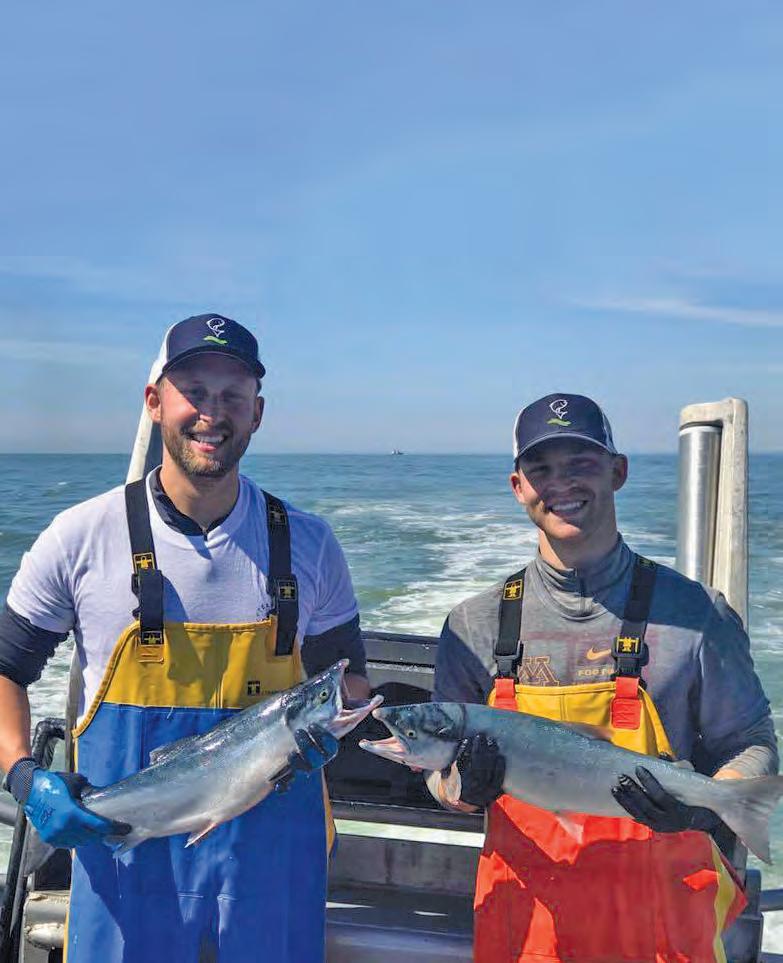





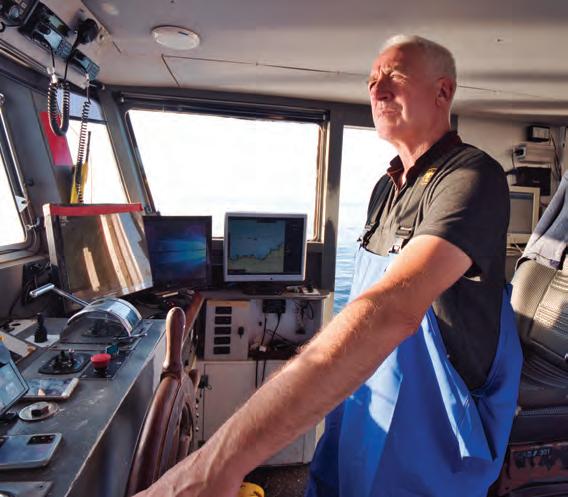




The quest to find the ultimate men’s watch has traditionally been a difficult one in the world of fashion. A timepiece with the perfect look and functionality has long been the goal of both watch designers and enthusiasts alike.
The Renegade Blue Chronograph Men’s Watch is the perfect combination of style and function. With a sleek design that features a bold blue dial, rose gold hands and hour markers, and a durable sports silicone band, this timepiece will instantly elevate any outfit.
The three sub-dials provide a precise timekeeping function. The sports silicone band is durable yet comfortable, providing a secure fit that won’t slide around on your wrist. The band is also easy to clean and maintain, making it perfect for everyday wear. The watch’s 30 Metre Water Resistance rating ensures that it has you covered whatever the occasion.
The Renegade Blue is also built to last, with a sturdy stainless steel caseback and exquisitely detailed bezel. The watch is powered by a super reliable quartz movement, which is covered by our incredible 5 Year Movement Warranty - ensuring accurate timekeeping for many years to come!
At the amazingly low price of just $99 plus S&H, this watch is an absolute steal. Don’t miss out on the chance to own the Renegade Blue and Rose Gold Chronograph Men’s Watch - order yours today!





If you’re searching for the ultimate holiday gi! for an angler, consider giving them a shing charter experience with a professional guide or charter captain. is gi! goes beyond typical shing gear; it’s an opportunity for adventure, skill-building, and unforgettable memories on the water.
A guided shing charter o ers the chance to sh in prime locations, o!en with access to secret spots that only locals know about. A professional guide or captain will lead the way, providing expert knowledge on local sh species, seasonal patterns, and specialized techniques. For anglers who love the thrill of landing big sh or are eager to explore new waters, this experience can be transformative.
Fishing charters also provide top-of-theline equipment and tackle, making it easy for anglers to focus on catching sh rather than gathering gear. Guides are well-versed in local regulations, making it a hassle-free experience without the worries of permits and licensing.


Whether the angler in your life is a seasoned pro or just starting out, a shing charter can be tailored to any skill level. It’s a personalized gi! that brings both relaxation and adventure, combining nature’s beauty with the excitement of a shing quest. is Christmas, give the gi! of a shing charter from one of our vetted Coastal Angler Magazine/ e Angler Magazine writers and you’ll be gi!ing an unforgettable experience every angler will cherish.
For more details, visit coastalanglermag. com or theanglermag.com and select the region where you’d like to sh, or you can easily nd a local captain’s contact info inside our print publication below their monthly shing forecast.













By Capt. Quinlyn Haddon
Ahhh December, the time of year for winter holidays, end of the year relaxation, winter nesting, comfort food, and family gatherings.
Unfortunately, you were well aware this was around the corner.
e Christmas music began beckoning to your wallets from every big box store in town, before the turkey le overs had even le your fridge. For no matter what this time of year means to you, there is no escaping the overbearing push for consumerism. Tis the season to spend your hard-earned money on disposable gi Trinkets and stu ers to $ll the house with “love”, only to be forgotten more quickly than they arrived. e gi s that have always been worth the most are the ones that create memories. e e orts to visit far away family and coupons for adventures to come may not be that exciting to unwrap, but the memories of them last a lifetime.

If you happen to make your way to the Florida Keys for the Christmas memories this December, our winter $shery has your back.

yellowtail and mangrove snapper are plentiful.
Wahoo and sail$sh are cruising the reef and can be reliably targeted without losing sight of land. is is always a nice feature for those who are not sure if they can handle the seas, as the ride back is reasonably noncommittal.
With windier days in December, it may seem o -putting to plan a $shing trip for risk of cancellations. e good news is that e Florida Keys boasts versatility between $shing the Atlantic waters, and the wind-sheltered waters of the Florida Bay.
e bayside waters are pretty much always shable, as far as wave heights are concerned, and it just so happens that they are in their peak time for productivity this time of year.
Our usual suspects are bigger, and we get lots of visitors running through. Snook, trout, mackerel, tripletail, and cobia are just a few of the species that make the bay more exciting during the winter.
If you missed your opportunity at cheaper Key’s accommodations before the rise of prices during Christmas break, keep your eye on the price drop a er the $rst week of January. e $shing forecast remains the same, but the tourism gouging will begin to fall back down.
With cooler water temperatures bringing our reef to life this month, you will have excellent opportunities to $ll your cooler nearshore, without having to worry about booking full days.
Grouper are still in season throughout this month, and the mutton,
If you don’t have plans to be in the Florida Keys over the winter break, Sweet E’nuf Charters sells printable gi certi$cates for you to gi this holiday season. We would be honored to be a part of making forever memories with you and your family.
Capt. Quinlyn Haddon guides with Sweet E’Nuf Charters based out of Marathon, Florida Keys. www.captainquinlyn.com; IG: @captainquinlyn






Whether you’re a weekend hobbyist or a seasoned angler, a llet knife is a tool that no angler should be without. Selecting the right one requires some thought, though, as there are many factors to consider.
By Bill Chamberlain
e material of the blade is crucial for both durability and performance. Most llet knives are made from stainless steel or high-carbon steel. Stainless steel blades are resistant to corrosion and rust, which is particularly important in wet environments. ey’re easy to clean and maintain, making them a great choice for anglers who frequently sh in saltwater. High-carbon steel blades, on the other hand, tend to be sharper and hold their edge longer, but they are more prone to rust and require regular maintenance. For most anglers, stainless steel is a safe and reliable option, especially if they spend time shing in saltwater environments. However, if you are diligent with tool maintenance, a high-carbon steel blade could o er a superior cutting experience.
e $exibility of the blade is another key consideration when choosing a llet knife. Fillet knives are designed to be $exible, allowing the angler to easily maneuver the blade around bones and skin sh. e level of $exibility o en depends on the length of the blade, with shorter blades being more rigid and longer blades o ering more $ex.
For general use, a blade length of around
six to seven inches is perfect. is size is versatile enough to handle most sh species, from pan sh to larger catches. However, if you regularly go a er bigger sh, like salmon or grouper, consider a longer blade, around nine to ten inches, to make lleting those larger sh easier. Conversely, a four to ve inch blade is ideal for those who prefer shing for smaller species.
A llet knife’s handle is just as important as the blade, as comfort and grip can signi cantly a ect performance. When lleting sh, especially in wet and slippery conditions, a good grip is vital to prevent accidents and ensure precise cuts. Look for handles made from materials like rubber or thermoplastic, which provide a non-slip grip, even when wet. Ergonomically designed handles with nger grooves o er additional comfort and control.Wooden handles are another option, o ering a more classic aesthetic. However, they can be slippery when wet and require more maintenance to avoid damage from moisture.
Traditional manual llet knives are the standard choice for most anglers, o ering a combination of control and simplicity. However, electric llet knives have grown in popularity, especially for those who frequently catch larger quantities of sh. Electric llet knives make quick work of lleting, cutting through sh with ease and saving time. If you o en processes multiple sh at once, an electric model could be a great

choice. at said, electric knives tend to be bulkier and more expensive, so for someone who enjoys the art of lleting by hand or who shes occasionally, a high-quality manual knife is likely a better t.
Consider whether the knife comes with a sheath or case for safe storage and transport. Anglers are o en on the move, and a protective sheath helps keep the knife safe and sharp while preventing accidents. Some llet knives also come with additional accessories, such as sharpeners or extra blades, which can be a nice added touch.
By focusing on the blade material, length, $exibility, handle comfort, and portability, you can nd a knife that enhances their shing experience and becomes a cherished tool for years to come.




By: Jessica Hendrie

Beneath South Florida’s waters, a silent invasion is taking place. As our native fish swim around in familiar currents, lurking among them are unexpected visitors, the snakeheads. These fish may be a delicacy in Asia but in Florida, they are highly invasive. Some would consider them a trash fish and once caught, just disposed of, but what most don’t know is that these fish can be cooked to perfection. Snakeheads can be mostly caught in canals with shiners or top water frogs. They usually are hungry fish so just about anything works, anywhere. Now when you’re out fishing in South Florida’s fresh water, some may think the peacock bass is invasive. But you’d be wrong. Peacock bass are exotic but not invasive in Florida waters. They are able to safely compete with largemouth bass and grow safely overall together. The snakehead is what you should keep an eye on. If caught, I challenge you to take it home and try it out cooked! Consider them most similar to a cobia when it comes to filleting. Once home and filleted, sauté the fillets in brown butter seasoned with salt, pepper, coriander and garlic powder. Serve over a bed of jasmine rice with a vegetable stir fry. If you want to make it even more “Florida,” grab a coconut and have refreshing coconut water as your beverage. Once served, you wouldn’t even know you’re eating a highly invasive snakehead. To give you a better idea of the taste, they are a very light and flaky white fish that have no fish taste whatsoever. So, some may even prefer it! Now that you have all this information on the snakehead, go try to catch one or two and not only will you be helping Florida waters, you’ll be able to have a wonderful dinner, too. Good luck and happy fishing!

By: Capt. Bart Marx

It was a crazy year in the weather department, and I am glad it’s over. For the holidays, if you are looking for a gift for one of those anglers in your life, I have gift certificates available, or they can be a good birthday gift too1 Inshore around the docks as the water gets cooler, the sheepshead will start chewing on the barnacles as they have some strong teeth and love crustations. Sheepshead are going into the Gulf to spawn when the waters get cooler in January and February. This is also true for the flounder population as they will be migrating into the Gulf to spawn as well. Flounder are more aggressive and will eat live baits like greenies, pinfish and shrimp. They will lay on the sand waiting for an unsuspecting bait to swim by. Drifting in the passes, tossing those little jigs for pompano can be productive for this fast-swimming species. Redfish on the grass flats and along the mangrove edges and on some of the coldest days they may be found in some deep pockets where the water temperature changes slower. Trout will be found on the grass flats hanging on the edges of the sand where there dark spotted back helps them blend in. Drift and you will cover more water and have a greater chance of finding some of those gator trout. Like all fish, trout will face into the current and wait for food to swim by or rise up and grab something off the surface. Black drum should be migrating up into the rivers, and you may see some big schools traveling together. This is the time of year to go offshore, weather permitting, and run the lines of stone crab buoys in search of tripletail. This is site fishing at its finest! Drive past the buoys and if you see what looks like a garbage bag around the line of the buoy, continue and make a large U turn and approach with a shrimp on a rod, cast to the buoy and watch the fish turn and come after the bait. And it is game time, back the boat away from the buoy and have fun. If you are traveling, you may find some cobia in small schools of 2 or 3 fish. Site cast to them also, and if you like bottom fishing get out to some of the natural ledges within 12 miles of the beach there should be snapper, lanes and mangrove. There should also be white grunts and several different porgies. If you would like to learn some of these methods of harvesting fish, give me a call or e-mail me at captbart@alphaomegacharters.com. I also do training sessions on your boat which helps shorten the learning curve and helps you learn where you can take your boat without destroying the local grass beds.

By: Capt. Dave Stephens

It's the last month of the year, let's hope we can close this one out and start 2025 brand new. The last couple months have been absolutely crazy here in Southwest Florida, as Mother Nature has thrown her best at us. Growing up here has taught me to be very resilient, and know better days are coming.
As we move into the winter months the rains that have stained our waters will begin to clear. The fish that you were not sure was in your favorite holes will be visible. It will not be long until this year will be a memory, a memory that will be replaced by memories of catching fish and spending enjoyable days on the water.
Signs of those days have already been showing their selves. On some of our recent charters we have been able to get clients personal best to the boat. Probably one of our local game fish that I would consider our least resilient, has proven to be very resilient which is the trout. On a recent charter, we were catching some nice reds on a bar and all of a sudden, the sea trout wanted to show up. We sat on this spot and caught trout up to 26”, it started out with your typical 16-18” fish then slowly kept increasing in size! The one thing that seemed to be the difference maker was tossing nice big pin fish at them. I guess sometimes big fish do want big bait. As we move into winter, I feel the bigger fish will continue to feed very heavily trying to get a little fat on them. Don't be afraid to toss a bigger bait out, as you never know what might happen. As the water begins to cool down, the snook bite will begin to slow, but we have plenty of other game fish willing to play, big trout and plenty of reds will be around.
If you would like to experience some of Southwest Florida's finest fishing, call us or send us an email. All of our charters are private and booked just for you!

Bay





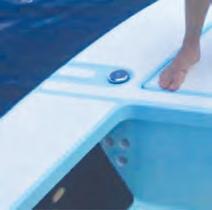







By: Capt. Terry Fisher

It is that time of year when the area lights up with numerous visitors and homeowners alike, returning from their summer habitats, to enjoy some of the best climate and pristine waters that Southwest Florida has to offer. It is also a time to reflect on another year gone by and a new one on the horizon. This is the time of year when returning family and friends get to relive memories and experiences of the past and forge new ones over the holidays. Many will have the opportunity to spend time on the water boating and fishing as part of their holiday celebrations.
December is a transitional month in regard to water levels and water temperature, which for the most part, determine the most productive species to target as well as their winter locations, challenging myself and other guides to make adjustments that ensure a good fishing and catching experience. Winter months bring additional challenges from the northern and northeasterly winds.
Low water levels not only restrict access to numerous areas for most boats, but they also change the location of fish. When this occurs, I begin to fish areas around docks (with current flow and deeper water) than those or spoil islands with little depth.
Migratory and reef species are affected mostly by water temperature. Fish temporarily relocate to areas that sustain their basic need of food for survival. This why in winter months fish such as, mackerel, permit, tarpon, cobia and pompano migrate south in contrast with the warmer months when they reverse their migratory pattern. Basically, they are following the food chain.
Non-migratory species such as reef fish (grouper, snapper, trigger) simply move to depths that meet their need which are shallower venues. The angler’s job is to find them, and they will be successful catching their target fish. Both migratory and reef species are following the bait with the water temperatures being the basic conduit that drives relocation.
Al l of the above begs the question: what fish will provide the best opportunity for anglers throughout the month of December and where will they be? It is common knowledge that sheepshead are the winter species to target as the larger ones living on the reefs during the summer months will move to shallow, inshore water depths around the rocks, docks and seawalls to spawn. However, all species are still available. The challenge is to find enough water to target them.
La rge grouper, snapper, triggerfish, grunts and other reef species will hold in depths of 85 ft. or less providing anglers a shorter distance from the outer islands to catch them. However, be aware of the harvest-
ing requirements for every species, depending on Federal or State Waters. They change from time to time. As of writing this article, Red Grouper is closed until January 1. Red Grouper are the easiest of the big three to catch (red, gag and black). There will be plenty of other species to catch and harvest.
Redfish, snook and other inshore species will inhabit areas of current flow, pockets of depth, most likely around passes and docks. Seatrout will be in the potholes of 3-5 foot or on the grass flats in the same depths. The techniques for fishing remain the same year around. Live or dead baits, artificial baits are all productive. Artificial baits will require the use of a trolling motor to keep moving to different locations along the shorelines and docks.
Inshore this month, as the colder fronts come in from the north, concentrate on sheepshead and mangrove snappers around docks and old piles using shrimps and fiddler crabs on small number 1 hooks. Fish the canals and passes for snook with white bait (pilchards), pinfish or artificial presentations. Big jack crevalle will likely in the canals and creeks. Look for black drum, redfish, snook, sheepshead and mangrove snapper on incoming and outgoing tides around the structures at Redfish, Captiva and Boca Grande Passes. Seatrout will hold in the 3-5ft. of grass flats and around the potholes. Look for spanish mackerel where birds are diving on baits. Silver spoons and pilchards will deliver success.
Offshore anglers can hope to score edible reef species as close as five to ten miles offshore as opposed to the thirty and forty mile runs during last summer’s extremely warm water temperatures. This I like to fish 50-100 ft. depths for the bigger fish. Wind velocity will be the dominant factor as to whether or not one goes out. Baits of choice will be pinfish, squid, pilchards and shrimps on a number 2/0 to 6/0 circle hook with leader and line size to match.
Fishing can be very productive in December as long as one concentrates on the nuances of the species being targeted. This is Captain Terry Fisher of Fish Face Charters wishing everyone a Merry Christmas, Happy New Year and ‘Tight Lines’!
Check out my website at www.fishfacecharters.com. Email me at fishfacecharters@yahoo.com or call direct at 239-357-6829 to schedule a charter on my vessel or yours. I am available as ‘Captain for Hire’ on your vessel by the hour for safety, navigational, fishing locations, and techniques that ensure every trip is successful.
Fish Face Charters | fishfacecharters.com | 239-357-6829

By: Joe Sheaffer

There are many different approaches to the inshore fishing game, including drifting, chumming, fishing points, docks, channels and I’m sure there are quite a few other strategies. These approaches can be very effective for a great day of fishing. I moved to S.W. Florida with Bass fishing experience and a cover water approach. I would fish productive areas with my trolling motor, covering water and making many casts. Bass anglers use power fishing to cover water and help them figure out a pattern. It didn’t take me long to try that approach down here, fishing to my strengths and comfort level. Making a few adjustments with my equipment and presentations, it has proved to be very productive.
The first key for this approach is having a boat and a trolling motor with
present, then my confidence is very high. The third key is lure presentation. I primarily fish artificial lures and I like using moving lures (examples: swim jig and paddle tails, spoons, swimbaits, top water lures and crankbaits). It is possible to use live bait as a presentation, but you may not cover quite as much area with a slower presentation. Another key is being able to make good, accurate casts without getting hung up or off target. This will help you be more efficient.
The philosophy is a numbers game. Cover more water, make many casts, put your lure in front of as many fish as you can and will improve your odds of finding aggressive fish. This style of fishing can also help you zero in on a pattern that will be productive throughout the day. I like my boat in con-
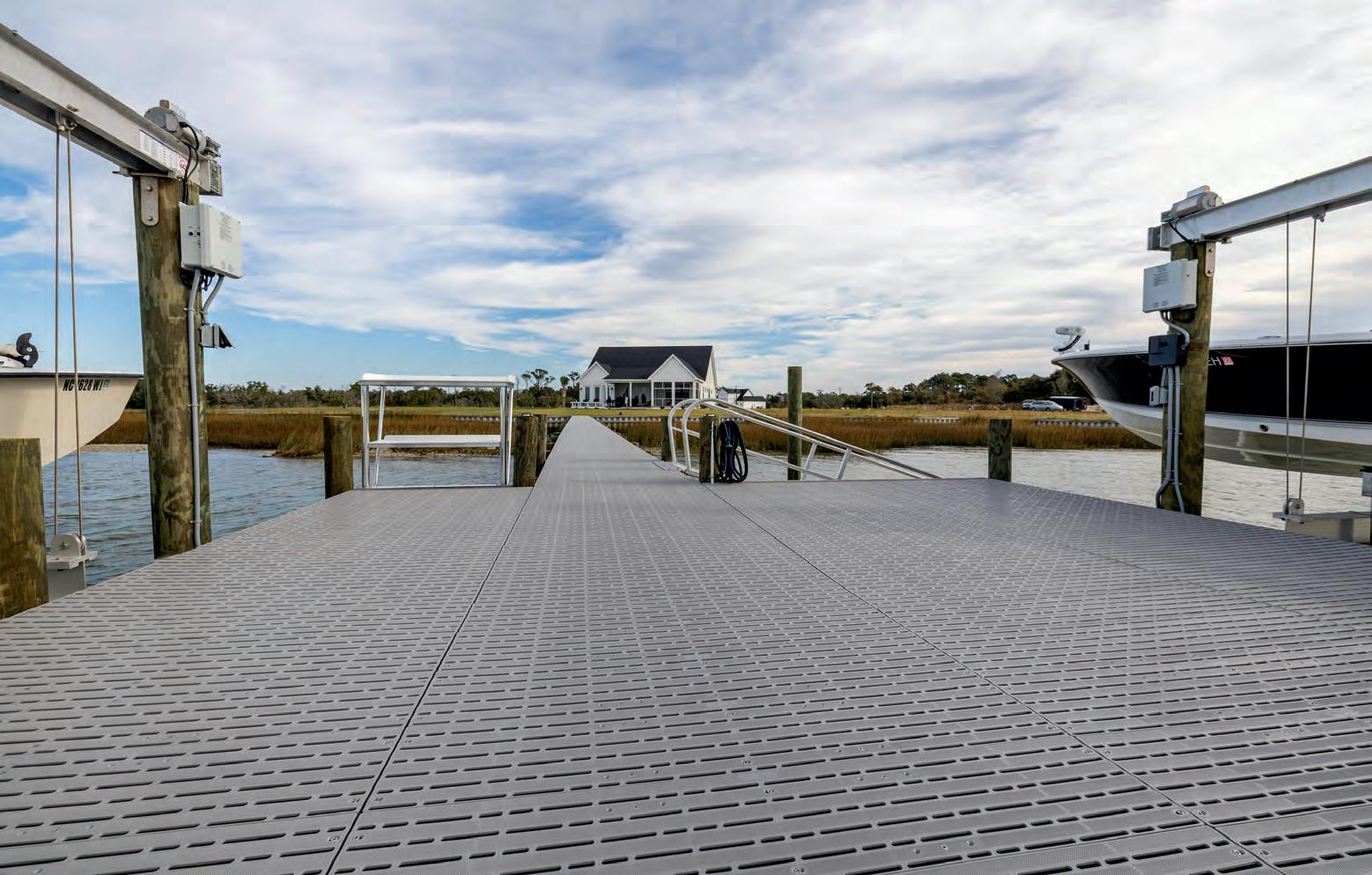




















3
4
12
13
14
18
20
22
27








































































































































By: Caitlyn Gatrell

We’re getting to that time of year when the temperatures drop, even if it's not by much in Florida, and the weather starts to change. Winter fishing in the Ten Thousand Islands is a fun adventure, with endless outcomes. I can't lie, I’m not a fan of the cold so my winter fishing trips are more limited. But of course, I get out there to experience the year-round fishing that Southwest Florida has to offer.
Winter fishing in the Ten Thousand Islands means fishing around alot of flats, points, mangroves, and oyster beds. This time of year, we are able to score nice sized pilchards off the beach, which seem to be highly enjoyed by nearby fish. If we have access to finger mullet, we also bring those guys along. In addition, the later months of the year are also known for artificial slays, where lures like Gulp Shrimp and DOA paddle tails are greatly enticing gamefish.
We often find ourselves hooking up to species such as sea trout, snook, redfish, jack, and of course, can't forget the ladyfish. Sharks are being seen frequently strolling around inshore, so we hook up to these guys too. Tarpon can also be found at times during the winter months, but you may have to be on the luckier side to catch one.
In addition to fishing, this time of the year is great for sightseeing in the Ten Thousand Islands. While out fishing we come across many marine species such as various birds, stingrays, turtles, dolphins, and manatees. We also come across bait schools and can see fish blowing up on them quite often. Not to mention, it's not as hot so it's a little more enjoyable to cruise around and fish. But if you don't love the cold like me, I suggest bringing a waterproof jacket and some pants for the ride!
If you read my article last month, then you'll remember I often take my dogs on our fishing trips! Winter fishing is excellent for bringing along your pups as the heat isn't present and they can enjoy the breeze while we fish. We usually pull up to an empty island and let them run and play while we get our bait. I love to explore with them and watch them go for a quick swim before we head to our honey holes.
Overall, the Ten Thousand Islands is a beautiful place to visit during the wintertime. The fishing provides some fun and a little bit of peace, and the scenery is to die for. If you haven't had an opportunity to visit during the winter, it's a must add to your bucket list!



by: Dan Carns
I personally tie the Tarpon loop on all my jigs and hooks to allow the hook/jig the ability to swing freely.

Irecently caught up with my friend Mike Westra at the Boat House in North Fort Myers. As is always the case we eventually talk fishing, and he said something about knots that never really occurred to me. “Knots” he said, “offer an amazing amount of freedom” and we discussed this statement at length. Fishermen are often in groups, either on shore, on bridges or in a boat and you may be required to tie many different knots depending on the day. Some of you are very proficient


at knot tying but all too often either a mate or someone in your group may be asked to tie a knot. Anglers are a proud sort and might be too embarrassed to ask about a certain knot so they’ll do their best with what they know whether its right or not. Maybe think back to your teen years when one of your buddies knew how to tie knots or maybe it was you. You probably needed them, or you wouldn’t go fishing. I often see people fishing with steel leaders and snap swivels in the entirely wrong place and wonder if someone else tied it on, so they didn’t have to retie the knots.
With all that being said how about us as kayak anglers. We are absolutely alone even if we’re fishing in a group so we must have a basic understanding of knots. Can you retie a knot in sixty seconds or some reasonable amount of time if it’s a hook, leader and sinker set up that you’ve broken off? If you want to increase your catch rate knots may be the single best way to get better at fishing. Understanding when the best time is to use a certain knot is also very important and either comes from experience or by watching videos online. Every lure or hook set up benefits from a certain knot configuration.
I personally tie the Tarpon loop on all my jigs and hooks to allow the hook/jig the ability to swing freely. This particular knot is exceptionally strong, and I’ve never had it fail even with a hundred-pound fish or more! The improved clinch knot is as reliable as any line to lure knot there is. It’s also been around a long time and suffers from not having a sexy new name or social media following but trust me it’s reliable and easy to tie. I believe the harder to tie knots come from the multiple material lines that have to be combined wether its braid to fluorocarbon or flurocarbon to monofilament. The Double Uni or the Yucatan are my favorite line to leader knots.
This is the single biggest hurdle for some anglers, but it is a skill that you should master. Fish are wary of steel leaders and snap swivels so find the knots that work for you. Go online, find a knot program and tie these over and over until they come naturally. Knots will singlehandedly improve your fishing game!
It’s A Wild World_Get Out There!
@paddlinandfishin
Dan Carns
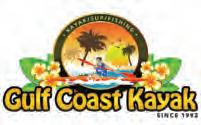


By: Mike Hammond
Ihope this article doesn’t apply to us for a long time. Unfortunately, paddling after a hurricane has been relevant too frequently the past few years.
I am often surprised how motivated some people are to paddle immediately after a major weather event. Respectfully, be patient and be safe. Please allow parks staff, outfitters and marina managers time to assess the damage and hazards after the storm. Many local government employees, including parks staff, take on different roles as a result of emergencies. They may be working in shelters or in emergency-response roles and are unable to check launches for several days after a hurricane or storm.
Please do not enter any closed areas. This only delays the recovery process and presents potential risk for your safety.
Check the Lee County Parks & Recreation website or social media channels for the most up-to-date information on openings and closures. Social media is also a good way to find out if marinas and outfitters have reopened by checking their official sites directly.
Every storm is different. While coastal areas may receive significant damage, inland waterways could be intact. Call the outfitters or parks staff located on the waterway you want to paddle and ask questions.

After Hurricane Milton, the Imperial and Estero rivers were fairly clear of debris but had strong currents that were not safe for the average paddlers. Estero River Outfitters and Calusa Ghost Tours both delayed putting people on the water until the water receded to manageable levels. I highly recommend attempting to paddle upstream first to determine if the current is too strong. If you can’t paddle upstream, you won’t be able to return to the launch if you start your paddle heading downstream.
If you want to meet other local paddlers, nothing is better than joining a cleanup. After storms there are always cleanup efforts within our area. Check with Keep Lee County Beautiful Inc., meetups and paddle club social media pages for events. Keep Lee County Beautiful Inc., held its Monofilament Madness event Oct. 26. Two large moving truckloads of debris were removed from the water and mangroves. It was a fun way to get on the water after the storm (Hurricane Milton) and make a difference in the community. It can be frustrating waiting for some of our favorite launches to reopen after a hurricane or weather event. Please be patient, get reliable information and stay safe!





was good for seatrout on


Sarasota life-David Walls with a beautiful 24” redfish on a DOA shrimp.

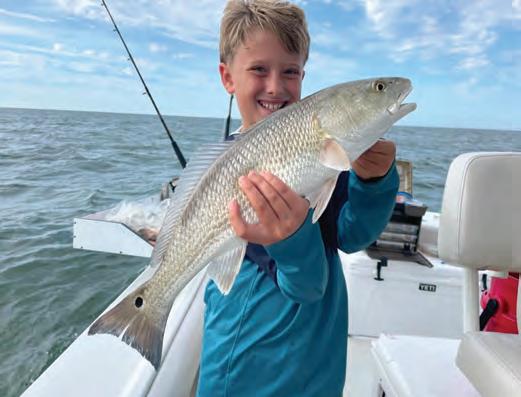





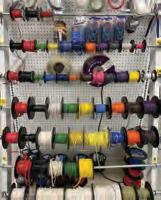
















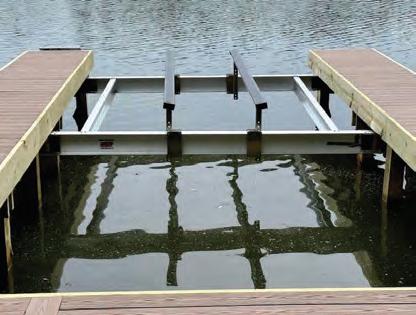




ShoreStation hydraulic boat lifts are a reliable choice for coastal residents and boating enthusiasts alike. Their strong construction, made with corrosion-resistant materials, allows them to withstand harsh environmental conditions, including sun, storms, and saltwater damage. ShoreStation provides a steadfast solution for protecting waterfront investments, o ering peace of mind to owners in the Sunshine State.








Equipped with exceptional weather resistant fabric and breathable SunTex 80 woven mesh ends for maximum protection and durability, the REVOLUTION™ Series Canopy is the most innovative canopy

Made from the highest quality materials, our innovative hydraulic boat lift is one of the fastest and safest lifts on the market today. When you have a hydraulic lift, there’s no need to worry about wind and waves getting in your way. This lift will give you con dence to safely land and secure your boat in less-than-ideal conditions.
Never miss another moment on the water. Power your lift with clean, free solar power. Our speedy 20 watt charger features solar regulator drainage protection, saving your battery from permanent damage caused by overcharging.








Compare before you sign with any other school www.adamsmarine.com
To Reserve a Spot Call: 352-447-1950 Email: info@adamsmarine.com




By Rod Wilson

Finding the ideal Christmas gi for an angler can be challenging. While rods, reels, and lures are popular options, tools like shing pliers and scissors are o en overlooked, yet essential. ese small tools can make a signi cant impact on an angler’s experience, ensuring smoother, more e$cient shing trips.
Pliers and scissors might seem like minor accessories, but they play critical roles. Pliers are used for removing hooks, crimping, cutting lines, and tuning lures. Scissors are vital for trimming shing lines, especially tough braided ones. High-quality pliers and scissors save time and e ort, allowing anglers to focus on shing.
When choosing shing tools, the material is crucial. Pliers and scissors must withstand water exposure, especially saltwater, which is highly corrosive. Stainless steel is common due to its rust resistance, but premium options like coated aluminum or titanium o er lighter and corrosionresistant alternatives. If the angler shes in saltwater, corrosion-resistant materials like anodized aluminum or titanium are ideal. Freshwater anglers can opt for stainless steel with a non-corrosive coating.
Comfort is another important factor. Fishing can be tiring, and uncomfortable tools add to the fatigue. Look for ergonomic designs with non-slip grips made from rubber or silicone for added comfort and secure handling, even in wet conditions.
Versatility in shing pliers is also worth considering. Many pliers today are multi-functional, incorporating features like line cutters, split ring openers, crimpers, and wire cutters. Multi-tool pliers reduce the number of tools an angler needs to carry. Scissors, too, vary in design, but their ability to cut through di erent line types, including mono lament, uorocarbon, and braided lines, is essential. Some even come with micro-serrated blades for enhanced cutting precision.




Portability is key for anglers who prefer to travel light. Fishing pliers and scissors should be compact yet functional. Many pliers come with a sheath and lanyard, making them easy to carry and preventing accidental loss in the water. For kayak or shore shing, compact and lightweight tools are best, while boat anglers can handle larger, feature-rich models without storage concerns.
Price is another factor to consider. While budget options are available, investing in high-quality pliers and scissors ensures longevity and better performance. Good pliers range from $20 to $50, while scissors range from $10 to $30. For dedicated anglers, it’s worth paying a bit more for durable, high-performing tools.
Choosing the right shing tools like pliers and scissors can make a thoughtful and practical Christmas gi . By considering material, comfort, versatility, size, and price, you can nd a gi that enhances their shing experience. Give the gi of convenience and quality this Christmas with top-notch shing tools any angler will appreciate.


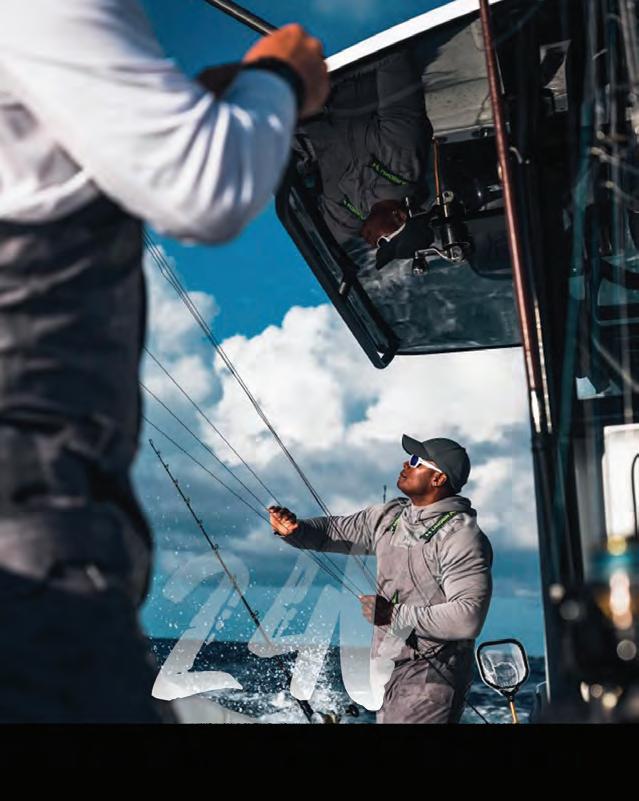












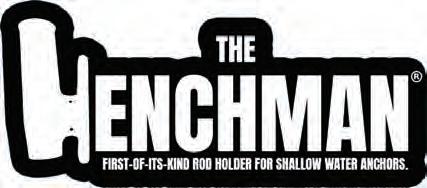

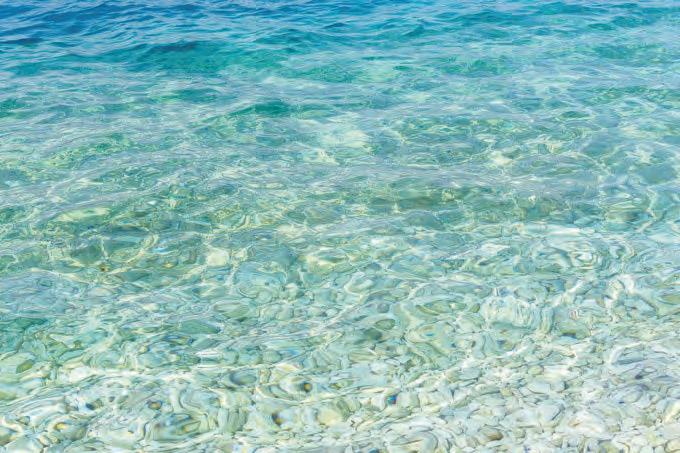













Who doesn’t love a good challenge? !at’s what draws so many anglers to light tackle for catching big sh. Mini rod shing takes it up a notch, turning the thrill of landing a monster into an even more rewarding experience. Mini-rod shing is all about having fun and enjoying the thrill of the catch!

At just 33 inches total, the Bean Pole isn’t just a mini in size, it’s the real deal in the world of shing. With a new edition released every year with cool colors and features, this little rod combines style, functionality, and fun all in one sleek package.
!e beauty of the Bean Pole is in its convenience. Slip it into your car, backpack, or even your kayak, and you’re ready to chase sh wherever the road takes you. Perfect for spontaneous road trips or shing in those hard-to-reach spots, this mini rod is your trusty sidekick for any adventure. While there are other “mini” rods on the market, ones over 36 inches fall more into the slow-pitch jigging category and are not considered real mini rods. !e Bean Pole, on the other hand, is a true mini rod at 33 inches. It’s designed for nimble casting and quick action, making it perfect for those who want a genuine mini experience without the extra length. Made from pure carbon ber, the Bean Pole is as lightweight as it is strong.
Don’t let its size fool you; this rod packs a punch! It’s designed to tackle everything from giant bull sharks to he y goliath groupers and, yes, it’s just as e ective at reeling in smaller species like snook and yellowtail snapper, giving it a ton of versatility!
e Bean Pole retails for $65 and is available at beansport shing.com.


SUZUKI MARINE’S DF2.5: Small in size but big in features. Weighing just 30 pounds, the portable and versatile DF 2.5HP outboard motor is the lightest Suzuki Marine USA 4-stroke motor ever built. This smooth, quiet engine is water-cooled for increased dependability, features a digital CDI, and its anti corrosion system ensures the aluminum propeller stays durable in marine conditions.

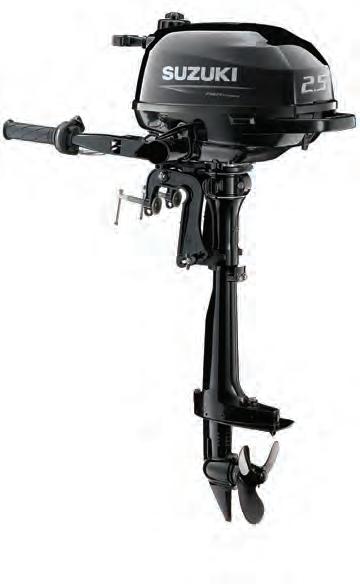




Christmas week, in my opinion, is the peak of bottom shing season, and there are plenty of reasons why. One of the biggest factors is the congregation of bait schools, like cigar minnows and sardines, which are some of the best baits available. Other reasons include the spawning aggregations and the cooler water temperatures. Speaking of bait, grouper (and American red snapper) can’t resist a few others if presented right: pin sh, sailor’s choice, and even small beeliners and other little snappers. !ese baits are so tempting because larger sh like grouper and snapper see them as egg-eaters. !ey devour them not only as a food source but also to protect their future o spring from these egg thieves. If you present these baits correctly—and avoid using bulky tackle— they’re simply too enticing to resist.
intelligent. Not all grouper species are equal in terms of smarts: red grouper are pretty naive, scamps are sharper, and gags are the brightest. !ey don’t become males, or black bellies, by being careless. Like other animals, sh learn to avoid obvious traps. !ey recognize mono, threeway swivels, heavy bank sinkers clanking on the bottom, and so on. It’s time to step up your game and target their instincts.
Personally, I use my weight as a “decoy,” making it resemble a crab or squid. !is setup involves a 4-foot piece of oro, a small 130-pound Spro swivel, and 50-pound braided line. I also color the rst 5 or 6 feet of high-vis (yellow) braid red with a Sharpie. (See my video on YouTube for a demo.) All these details matter for the overall presentation. !e

Let’s talk tackle. Forget mono lament altogether! I’ve spent a lot of time observing my tackle underwater, and mono is much more visible than uorocarbon. Compared to mono, oro is nearly invisible, which makes a di erence. Next, think carefully about the weight and terminal tackle you use to get bait to the bottom. While three-way rigs were a classic for years and will still catch younger (female) grouper, it’s a di erent story when they grow up. Once female grouper mature, they undergo a transformation and become males. When these gag grouper turn male, they also reach a size where we call them “black bellies.” !ese male grouper—especially black bellies—are




“Decoy Jig” is like psychological warfare; it taps into the sh’s hardwired drive to attack struggling or injured prey. !e Crab Decoy Jig, for example, looks like a crab holding on to a struggling snapper. To a wary grouper or big snapper, that’s an irresistible “Happy Meal.” I came up with the Crab Decoy Jig a er gutting thousands of grouper and realizing that their diet mostly consists of small red and reddish-brown crabs, tiny snappers, cigar minnows and sardines.
!e gag grouper and American red snapper populations are stronger than they’ve been in years—just ask any diver! But to catch them consistently, you need to improve your presentation. If you’re not catching gags and scamps with your old “chicken rig,” it doesn’t mean there aren’t any grouper around. !ey’re just not falling for poorly presented bait.
For a closer look at my setup, visit my YouTube channel.
MERRY CHRISTMAS!
See more from Tim Barefoot at www.barefootcatsandtackle.com and on YouTube @timbarefoot5698.




































The International Game Fish Association (IGFA) tracks record sh catches around the globe. Here are a few highlights from their newly approved world records.
To see all newly approved IGFA world records go to igfa.org.
Shapiro’s Red Drum

On July 8, 2024, Shawn Shapiro was shing the Chesapeake Bay out of Norfolk, VA, when he landed this massive 45.7-inch red drum. Shawn was shing with a live croaker aboard his father’s boat “Sea Mes” when this record red sh struck. With this sh Shawn has set the IGFA All-Tackle Length Junior World Record for the species. A er recording the length and snapping a few photos, he was able to release the sh safely.
Martin’s
On May 17, 2024, Vicki Martin landed a stunning 4-pound brown trout while shing the White River in Arkansas. !is catch has earned Vicki the IGFA Women’s 2 lb. Line Class World Record for the species. With the help of guide Craig Yowell, Vicki landed the record trout a er a six-minute ght.

On June 29, 2024, Peter Fox was shing out of Brabant Lodge in Northwest Territories, Canada when he landed this impressive northern pike. Peter was using a prop y when the pike struck and was able to boat the sh a er an intense ght. !e sh measured 43.3 inches, earning Peter the IGFA All-Tackle Length Fly World Record for the species.
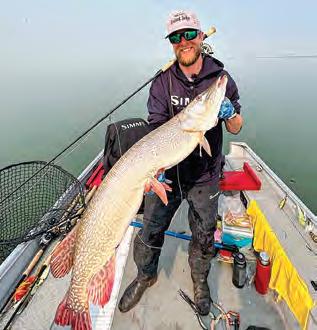

On May 12, 2024, Jan Gredysa was Shinnecock, NY, when he landed this 22.4-inch summer ounder. With this has set the IGFA All-Tackle Length Junior World Record for the species. Jan was casting a Fin-S lure when this record ounder struck and was able to land the sh a minute ght.

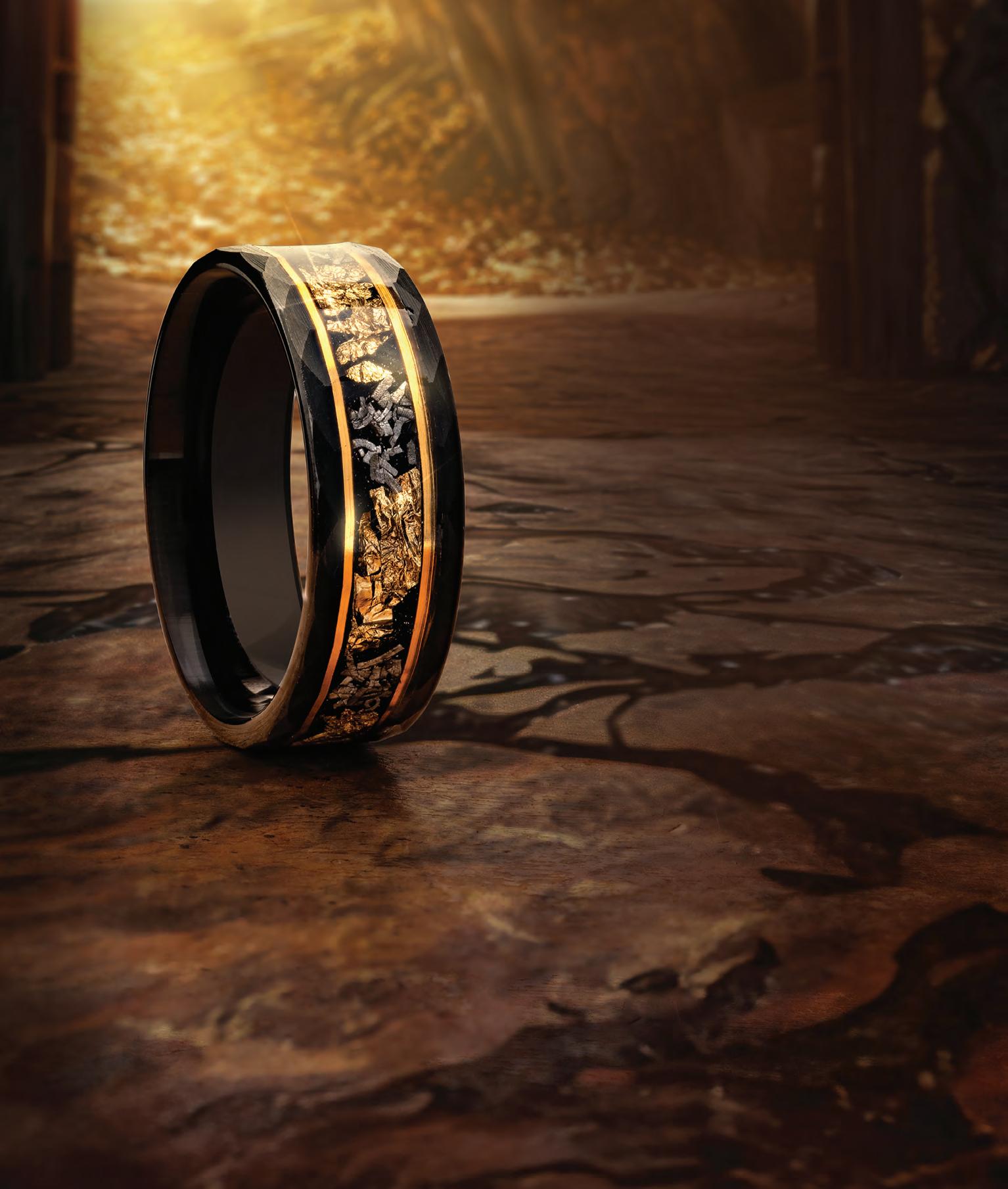


ImpossiblePriceWas $299, Now


Ah, my dear compatriots, allow me to share a tale of intrigue and fortune. Picture this: a venture into the heart of a South American goldmine, where the earth yields its treasures to the daring and the cunning. With every step as we follow Diego, our mining master, the air thickens with anticipation, the scent of wealth mingling with the thrill of the unknown.
Tere, amidst the darkness, lies the prize we seek — veins of gold, glimmering like stars in the night sky.
Now picture this: a ring, not just any ring, mind you, but a masterpiece crafted to adorn the fingers of the discerning. Crafted with meticulous care, each piece encasing ribbons of 24 karat gold in a Tungsten setting, whispering tales of luxury and prestige.
“Been

Meticulously crafted and amazingly comfortable, you will not find anything like this in a jewelry store. As gold prices skyrocket, we have been able to craft this and hold the price under $100 making it exclusively available with only 495 reserved for this ad. And of course we offer a 30 day no questions asked guarantee.


Yanacocha Gold Mine, located near Lima, Peru, is the largest gold mine in South America and the fourth largest in the world.
SOLD OUT IN HOURS NOW BACK IN STOCK
A symbol of power and sophistication. Tis isn’t just a ring, it’s a statement. On any adventure, let this ring be your companion, a silent witness to your every triumph. Ahhh… the rush of a gold rush.
Jewelry Specifcations:
• 24k gold embedded in black-finished tungsten
• Whole Size 8 -14
Men’s Gold Rush Ring
$299 $99* + S&P Save $200

*You must use Insider Offer Code GRR161-01 to get this price.






























